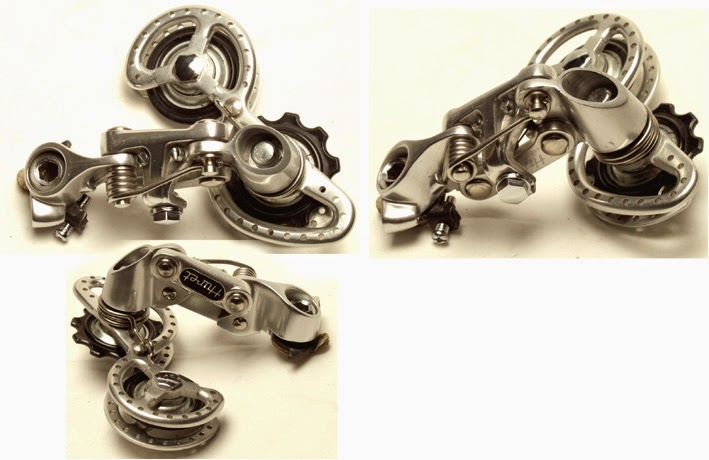A few years ago, it seemed that "drillium" might make a comeback. A few companies, including Velo Orange, were offering drilled-out versions of chainrings and other components. Some still are. VO's drilled-out chainrings are actually pretty: They seemed seemed to be covered with pindots. I'd actually put them on one or two of my bikes.
Back in the heyday of drillium, it seemed that anything and everything that could take a drill--and a few things that couldn't--got the treatment. In addition to chainrings, shift levers and brake lever handles commonly got drilled. When I first began to work in a bike shop, one of the jokes about Lambert/Viscount bikes was that they came with drilled-out tires and water bottles.
Seriously, though, some cyclists were manic with drills. I saw toe clips and other kinds of clips--for brake cables and water bottle cages--perforated, ostensibly in the name of saving weight. Sometimes, components that really didn't need to be any lighter were riddled with pockmarks, like the Huret Jubilee, still the lightest (and to my eye, prettiest) rear derailleur ever made. Or this derailleur I saw on eBay:
The first-generation SunTour Cyclone might be the second-lightest rear derailleur ever made. It's certainly lighter than any made today. Oh, and I think the silver version with the black inset is the second-prettiest derailleur ever made: all the more reason it shouldn't be defaced with a drill!
Back in the heyday of drillium, it seemed that anything and everything that could take a drill--and a few things that couldn't--got the treatment. In addition to chainrings, shift levers and brake lever handles commonly got drilled. When I first began to work in a bike shop, one of the jokes about Lambert/Viscount bikes was that they came with drilled-out tires and water bottles.
Seriously, though, some cyclists were manic with drills. I saw toe clips and other kinds of clips--for brake cables and water bottle cages--perforated, ostensibly in the name of saving weight. Sometimes, components that really didn't need to be any lighter were riddled with pockmarks, like the Huret Jubilee, still the lightest (and to my eye, prettiest) rear derailleur ever made. Or this derailleur I saw on eBay:
The first-generation SunTour Cyclone might be the second-lightest rear derailleur ever made. It's certainly lighter than any made today. Oh, and I think the silver version with the black inset is the second-prettiest derailleur ever made: all the more reason it shouldn't be defaced with a drill!














-filtered.jpg)


